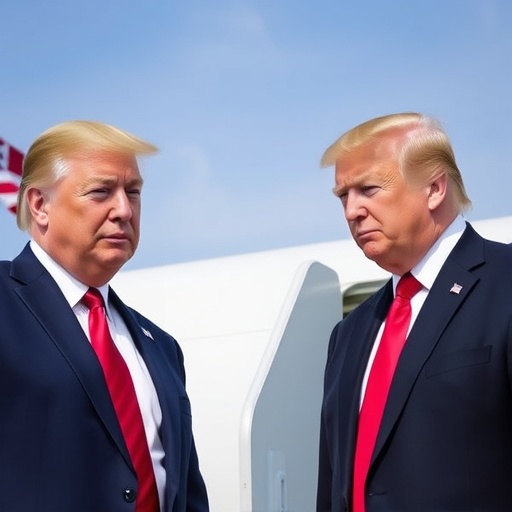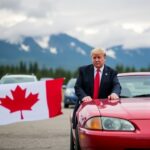Trump‘s Urgent Asia Trip Targets Breakthrough in Escalating China Trade War
In a move that could reshape global economic dynamics, President Donald Trump is jetting off to Asia for a series of high-stakes meetings, with the spotlight firmly on crunch talks with Chinese President Xi Jinping. As the U.S.-China trade war intensifies with fresh tariffs and retaliatory measures, this summit arrives at a pivotal moment, offering a glimmer of hope amid mounting tensions that have already cost billions and rattled markets worldwide.
Trump‘s departure from Washington comes just days after the U.S. imposed new duties on $200 billion worth of Chinese goods, prompting Beijing to counter with tariffs on American agricultural products. Sources close to the White House describe the trip as a “make-or-break” effort to de-escalate the conflict that has defined much of Trump’s economic agenda since 2018. With the 2020 election looming, the president is under pressure to deliver tangible wins, making these negotiations more than just trade talks—they’re a test of his ‘America First’ doctrine.
Trump’s Packed Asia Itinerary: From Tokyo to Beijing
President Trump’s Asia tour kicks off in Tokyo, where he’ll meet Japanese Prime Minister Shinzo Abe to discuss not only the bilateral trade deal signed earlier this year but also strategies to counter China’s growing influence in the region. Japan, a key U.S. ally, has been navigating its own frictions with Beijing over territorial disputes in the East China Sea, making this stop a strategic prelude to the main event.
From there, Trump heads to South Korea for talks with President Moon Jae-in, focusing on North Korea denuclearization efforts intertwined with economic pressures from the trade war. Seoul has expressed concerns over supply chain disruptions caused by U.S.-China tariffs, which have hit its tech and auto sectors hard. A White House official, speaking on condition of anonymity, revealed that Trump plans to leverage these alliances to present a united front against unfair Chinese trade practices.
The crown jewel of the itinerary is the two-day summit in Beijing with Xi Jinping, scheduled at the Great Hall of the People. This will be their sixth face-to-face meeting since the trade war began, but insiders say the atmosphere is more charged than ever. Trump has publicly praised Xi as a “very good friend” while simultaneously blasting China for intellectual property theft and currency manipulation—tactics that underscore the personal rapport he hopes to rebuild.
Completing the circuit, Trump will touch down in Vietnam for a multilateral forum on regional trade, where he’ll rally Southeast Asian nations wary of China’s Belt and Road Initiative. The trip, spanning over a week, involves more than 20 hours of flight time and multiple time zones, testing the 73-year-old president’s stamina as he pushes for concessions that could avert further economic fallout.
Tracing the Escalation: How the Trade War Reached Boiling Point
The U.S.-China trade war didn’t erupt overnight; it’s the culmination of decades of simmering grievances. It officially ignited in March 2018 when Trump slapped tariffs on steel and aluminum imports, citing national security concerns. China retaliated swiftly, targeting U.S. soybeans, pork, and automobiles—staples of Trump’s rural base. By mid-2019, the conflict had ballooned, with the U.S. imposing duties on over $360 billion in Chinese imports and Beijing hitting back with $110 billion in countermeasures.
Statistics paint a stark picture: According to the U.S. Trade Representative, the trade deficit with China stood at $419 billion in 2018, fueling Trump’s rhetoric that America was being “ripped off.” Economists estimate the war has shaved 0.3% off U.S. GDP and cost 245,000 American jobs, per a Federal Reserve study. On the Chinese side, exports to the U.S. dropped 12.5% in 2019, hitting manufacturing hubs like Guangdong province hardest.
Recent escalations include Trump’s September 2019 announcement of 15% tariffs on $300 billion more in goods, from toys to textiles, just ahead of the holiday shopping season. China responded by suspending purchases of U.S. farm products and allowing the yuan to weaken beyond seven to the dollar—a move the U.S. labeled as manipulation. “This is economic warfare, plain and simple,” Trump tweeted last week, vowing to protect American workers from what he calls China’s “predatory practices.”
Amid the brinkmanship, smaller victories have emerged. Phase One of a trade deal in January 2020 saw China commit to buying $200 billion in U.S. goods over two years, though compliance has lagged due to the COVID-19 pandemic. Now, with global supply chains fractured, the war’s toll extends beyond borders—European automakers like Volkswagen have seen profits dip 20% from disrupted parts flows, while Indian steel exports to the U.S. surged 50% as an alternative source.
Critics, including former Obama advisor Ben Rhodes, argue the trade war has backfired, empowering Chinese nationalists and accelerating Beijing’s push for self-reliance in tech sectors like semiconductors. Yet Trump supporters point to reshoring efforts, with companies like Apple exploring moves from China to India and Vietnam, as proof of the strategy’s long-term merits.
Spotlight on Beijing: Agenda for the Trump-Xi Summit
At the heart of Trump’s Asia trip are the closed-door discussions with Xi Jinping, where the agenda spans trade imbalances, technology transfer, and geopolitical flashpoints. Topping the list is enforcement of the Phase One deal, with U.S. officials demanding China ramp up agricultural purchases—currently at just 58% of commitments, per Peterson Institute data.
Intellectual property remains a flashpoint. The U.S. accuses China of forcing joint ventures that steal American tech secrets, a claim Beijing denies but has addressed through new laws. Trump is expected to push for verifiable reforms, possibly tying them to tariff rollbacks. “We need fair play, not forced technology handover,” a senior trade negotiator told reporters en route to Asia.
Beyond economics, the talks will touch on Huawei’s role in 5G networks, with the U.S. urging allies to ban the firm over espionage fears. China, in turn, seeks relief from export controls on rare earth minerals critical for U.S. defense tech. Quotes from Chinese state media hint at Xi’s firm stance: “China will not bow to pressure,” Xinhua reported, signaling no easy concessions.
Human rights issues, including Hong Kong’s pro-democracy protests and Uighur detentions in Xinjiang, may surface indirectly through trade linkages. Trump has downplayed these, prioritizing economics, but congressional hawks like Senator Marco Rubio are lobbying for tougher language. The summit’s structure includes a private dinner—reminiscent of their 2017 Mar-a-Lago meeting—where personal chemistry could sway outcomes.
Supporting the bilateral talks, a U.S. delegation led by Trade Representative Robert Lighthizer and Treasury Secretary Steven Mnuchin will huddle with Chinese Vice Premier Liu He. Their sessions aim to draft a Phase Two framework, potentially covering services trade and currency stability, though analysts doubt a comprehensive deal before 2021.
Market Jitters and Global Ripples from the Trade War Standoff
News of Trump’s Asia trip sent shockwaves through financial markets, with the Dow Jones Industrial Average climbing 1.2% on hopes of a breakthrough, while the Shanghai Composite dipped 0.8% amid uncertainty. Currency traders watched closely as the yuan strengthened slightly against the dollar, betting on de-escalation signals from Beijing.
The trade war’s broader impacts are profound. U.S. farmers, hammered by lost Chinese markets, have received $28 billion in federal aid since 2018, yet many soy growers in Iowa report 20-30% revenue drops. Manufacturers like Boeing have lost orders worth $20 billion as Chinese airlines pivot to Airbus. In China, small exporters face bankruptcy, with over 1,000 factories shuttered in the Pearl River Delta last year alone.
Globally, the WTO forecasts a 0.5% drag on world trade growth due to the conflict. Emerging markets like Brazil have boomed as soy suppliers to China, exporting a record 82 million tons in 2019, while Mexico’s auto industry suffers from U.S. tariff uncertainties. Tech giants such as Qualcomm and Intel report $10 billion in lost revenue from restricted Chinese sales.
Experts weigh in with mixed views. “This summit could unlock $100 billion in pent-up trade,” says Chad Bown of the Peterson Institute, but warns of “illusory progress” if structural issues like subsidies aren’t addressed. On the bullish side, Goldman Sachs economist Alec Phillips predicts a 10% tariff reduction could boost U.S. GDP by 0.2%. Consumer prices have risen modestly—washing machines up 12% post-tariffs—but inflation remains contained at 2.1%.
As the trip unfolds, investors are glued to every tweet and statement from Trump, whose unpredictable style has swung markets wildly before. A breakthrough might stabilize supply chains strained by the pandemic, but failure could trigger Phase Two tariffs, escalating the trade war into uncharted territory.
Outlook: What a Trump-Xi Deal Could Mean for US-China Ties
Looking ahead, the outcomes of Trump’s Asia sojourn could redefine U.S.-China relations for years. A successful summit might pave the way for a broader pact, easing tariffs and fostering cooperation on climate change and pandemics—areas where mutual interests align despite rivalry.
Optimists envision diversified global trade, with the U.S. courting partners in Europe and Asia to reduce China dependence. The U.S.-Mexico-Canada Agreement (USMCA), effective July 2020, already redirects some manufacturing northward. China, meanwhile, accelerates its “Dual Circulation” strategy, boosting domestic consumption to weather external storms.
Yet risks loom large. If talks falter, Trump has hinted at 25% tariffs on remaining Chinese imports, potentially igniting a full-blown recession. Geopolitically, failure could embolden China’s assertiveness in the South China Sea, straining alliances like the Quad (U.S., Japan, India, Australia).
Post-trip, Trump plans a Rose Garden address to tout results, while Congress eyes oversight hearings. For everyday Americans and Chinese citizens alike, the stakes are personal: lower prices, job security, and a less volatile world economy. As Trump boards Air Force One, the world holds its breath for what could be a turning point in the trade war saga—or its most contentious chapter yet.
In the coming weeks, follow-up negotiations in Geneva via the WTO could build on any Beijing gains, with implications rippling to the 2024 G20 summit. Whether this trip marks detente or deadlock, it underscores the enduring U.S.-China rivalry shaping the 21st century.








